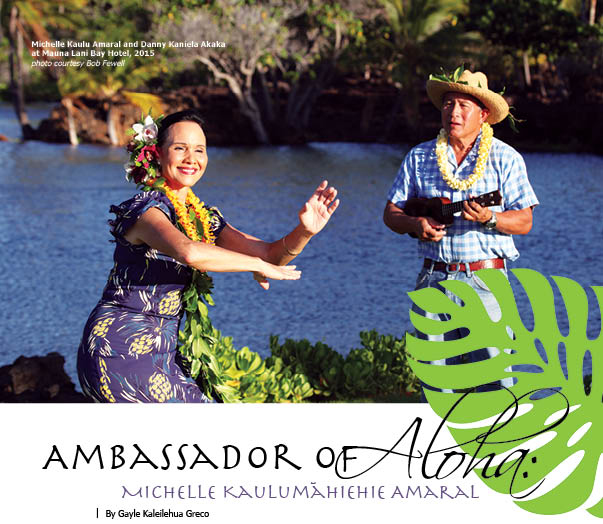
Healing Plants: ‘Ākia
 By Barbara Fahs
By Barbara Fahs
If you look around the grounds of Kona-area hotels, condominiums, and vacation rentals, chances are you might discover ‘ākia used as an attractive groundcover plant.
It’s an endemic Hawaiian plant that botanists call Wikstroemia uva-ursi, or hillside false ‘ōhelo. If you’re familiar with the herb commonly called uva ursi (Arctostaphylos uva-ursi), this Hawaiian plant with a shared name is very different. “Uva” translates to “grape” or “berry,” while “ursi” means “bear.” So the nickname for both plants is “bear berry,” due to the similarity of the red fruit, which resembles berries that bears eat in other climate zones. This nomenclature points out the importance of learning the botanical names and properties of plants before we attempt to use them medicinally or for food.
Appearance and Distribution
‘Ākia is a sturdy, low-growing native with dense branches and small, pale green, oval leaves. In season, it produces small yellow flowers and later, red berries that grow no larger than ¾ inch in diameter. It can spread to several feet and also can grow three or four feet tall.
‘Ākia is native to dry, open, lowland, or coastal habitats on Kaua‘i, O‘ahu, Moloka‘i, and Maui, according to Hawaiian Native Plants. The University of Hawai‘i also reports that ‘ākia occurs in windy spots near the ocean, on ridges to 1,400 feet, and on ‘a‘ā lava. It is rarely found in the wild today. Along with naupaka, pōhinahina, and the white Hibiscus arnottianus, it is one of the most common Hawaiian plants used in landscaping.
Growing ‘Ākia for the Landscape
‘Ākia works well in dry leeward gardens because it has few cultural needs. It can be trained to form a low hedge and its yellow flowers and red berries add color to dry environments. A slow grower, ‘ākia thrives under drought conditions and is resistant to insect pests and plant diseases.
To propagate ‘ākia, collect ripe berries, each of which normally contains one seed. Allow the berries to fully ripen in a plastic bag for several days. Then follow these steps:
- Scrape away the fleshy pulp under running water by rubbing each berry on a sieve or strainer.
- Soak seeds in water for 24 hours.
- Prepare pots with moist vermiculite and then press several seeds into this medium and cover with ¼ inch of sterile potting soil.
- Cover pots with moist sphagnum moss and keep them in an area with several hours of sunlight each day. Water daily. Expect germination within two weeks to three months.
- When germination begins, remove the moss.
- Allow seedlings to develop several sets of true leaves before you transplant them to the garden or to individual pots.
- Water young transplants periodically until they begin to sprawl and take root.
Traditional Uses
Although ‘ākia is nontoxic to humans, it was used in ancient times as a fish sedative. It’s one of the few Hawaiian plants that is toxic to cold-blooded animals. Hola is a method of fishing that utilized the roots, bark, leaves, and stems of ‘ākia as a fish sedative. Ancient Hawaiians pounded the plant with chum and then poured the mixture into fishponds. After the fish ate the baited plant material, they behaved as if they were drunk, making it easy to collect them.
‘Ākia was used in several other ways:
- The berries have been used in lei making;
- Extracts made from ‘ākia are believed to have anti-tumor capability;
- The wood from larger species of Wikstroemia was used for ‘auamo, or carrying sticks;
- Branches also provided one of the strongest fibers known in Hawai‘i—it was used to make ropes and braids;
- ‘Ākia’s fiber also may have been used for creating kapa (tapa cloth);
- Mixed with coconut and sugarcane, the sap was given along with sweet potato as a purgative to cleanse the body of toxins;
- A close relative, ‘ākia kuahiwi, was used to treat asthma and constipation.
Safety
Toddlers (or pets) who eat ‘ākia berries will not be affected by the narcotic that stuns fish; it appears that the stems, leaves and roots contain the chemicals that cause fish to become catatonic. It’s better to be safe than sorry, however, as Native Plants Hawai‘i cautions, “It is probably best to side with caution and avoid ingesting any parts of ʻākia until sound information is available.” ❖
Top photo courtesy Forest and Kim Starr
Contact writer Barbara Fahs
References/Sources:
HawaiianNativePlants.com/ourplants/akia
Hawaii.edu/eherring/hawnprop/wik-uvau.htm
NativePlants.hawaii.edu/plant/view/Wikstroemia_uva-ursi
HawaiianNativePlants.com/ourplants/akia-kuahiwi
Fws.gov/refuge/kilauea_point/wildlife_and_habitat/Akia.html
Cieer.org/geirs/regions/oc/usa_hi/ebot-46-3-241.html


